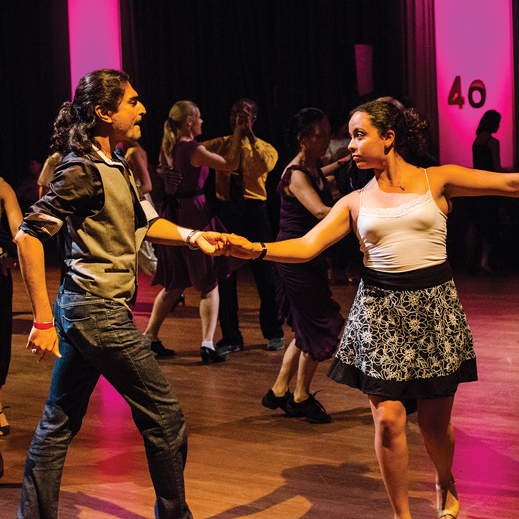A college campus teeming with engineers and scientists may seem like a surprising place for a thriving ballroom dance community. Yet MIT’s Ballroom Dance Team is perennially top-ranked, and the Ballroom Dance Club celebrated its 40-year anniversary in August.

“I’m sure some people are surprised that MIT has good ballroom dancers,” says Allison Chang, PhD ’12. “It can be a rigid place, but ballroom dance fits that image better than any other kind of dance. There are techniques and rules about movement. A big reason MIT students excel at it is because it gives you structure.”
In fact, a few MIT alumni have gone on to notable success in ballroom dance. The club’s first president, Jeff Alexander ’74, SM ’76, PhD ’78, and his wife, Janelle, have won high-level dance competitions in the United States and England, and Daniel Radler ’79 and his partner, Suzanne Hamby, went pro after being a top amateur team and ended up being ranked third in the U.S.
“When I first arrived at MIT in 2005, I was surprised to find out MIT even had a ballroom dance club,” says club vice president Attila Forruchi, a visiting scholar at the Media Lab. “But it’s been a great way to meet people across campus. Our monthly social dances feature alumni who are in town for a visit and community dancers from greater Boston.”
MIT’s ballroom dancing tradition dates back to 1974, when students from MIT and Wellesley College began meeting a few times per week. Initially known as the MIT/Wellesley Ballroom Dancing Club, the club became more MIT-centric after the Institute began offering ballroom dance courses during IAP in the mid-1970s. It officially became the MIT Ballroom Dancing Club in 1978, and membership grew throughout the 1980s.

More members became interested in dancing competitively, so the separate MIT Ballroom Dance Team was created in 1991. The MIT Open, an annual competition hosted by the team, features more than 150 dancers.
Today, the noncompetitive club is cross-generational and holds instructional workshops up to three times a week, as well as Saturday-evening social dances once a month. Though open to all, it is made up mainly of MIT community members.
“It became my primary extracurricular activity when I was at MIT,” Chang says. “It was an important part of my life and created a nice balance with my academic work.”
Club members have varying levels of experience, but all benefit from classes taught by local professional instructors.
“It’s very addictive,” Forruchi says. “Everyone starts without a formal dance background—almost everyone is a beginner of some sort. I used to play soccer in semiprofessional leagues, and I was looking for something healthy. Ballroom dancing was perfect.”
For more information on the MIT Ballroom Dance Club and to read a comprehensive history on ballroom dancing at MIT, visit web.mit.edu/bdclub/.
Keep Reading
Most Popular
Large language models can do jaw-dropping things. But nobody knows exactly why.
And that's a problem. Figuring it out is one of the biggest scientific puzzles of our time and a crucial step towards controlling more powerful future models.
How scientists traced a mysterious covid case back to six toilets
When wastewater surveillance turns into a hunt for a single infected individual, the ethics get tricky.
The problem with plug-in hybrids? Their drivers.
Plug-in hybrids are often sold as a transition to EVs, but new data from Europe shows we’re still underestimating the emissions they produce.
Google DeepMind’s new generative model makes Super Mario–like games from scratch
Genie learns how to control games by watching hours and hours of video. It could help train next-gen robots too.
Stay connected
Get the latest updates from
MIT Technology Review
Discover special offers, top stories, upcoming events, and more.